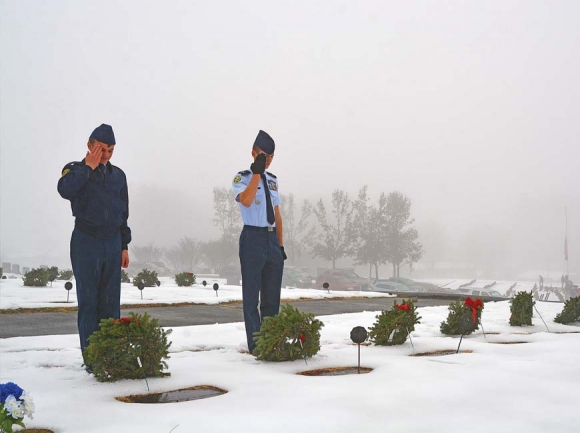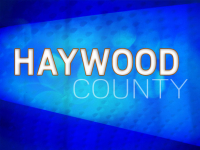Common ground found in Green Hill Cemetery spat
 Cadets from the Tuscola High School AFJROTC place wreaths in Green Hill Cemetery the morning of Dec. 16. Cory Vaillancourt photo
Cadets from the Tuscola High School AFJROTC place wreaths in Green Hill Cemetery the morning of Dec. 16. Cory Vaillancourt photo
Long-established rules and regulations created by the Town of Waynesville that proscribed periodic cleanup of the town’s historic Green Hill Cemetery upset family members of the deceased, who were taken aback — and, they say, by surprise — when the cleanup resulted in dozens of shrubs, statues, vases and floral arrangements being cleared from plots.
“We all understand we need to maintain it. Let’s do whatever we can for maintenance and the whole nine yards. We’re not asking them to go out there with a pair of scissors and we don’t care how long it takes — that’s not what we’re doing,” said Scott Ybanez, chairman of an ad-hoc group of concerned citizens calling itself the Green Hill Cemetery Committee. “We just want people to be able to mourn their loved ones in whatever manner they see fit without it upsetting maintenance.”
How that will be done in the future has been and will continue to be the subject of intense public debate, after a packed boardroom at a Dec. 13 town meeting saw almost two dozen speakers call the entire situation “despicable” and “disrespectful.”
Cemetery regulations had been in place in the Town of Waynesville since at least 1966, but probably even for 80 years earlier than that; town ordinances were revised in 1987 and then again in 1995 after Hazelwood became part of Waynesville.
That didn’t stop complaints about Green Hill Cemetery’s appearance, like those of former alderman Sam Wiggins in 1999. More than a year later, Mayor Henry Foy established a cemetery committee, and five years after that, in 2005, signage regarding prohibited items was erected.
In 2009, changes to the ordinance proposed by then town manager Lee Galloway were discussed at the board of aldermen’s annual retreat and in April of that year, the original “ordinance 18,” as it’s now known, was passed.
Related Items
In that ordinance, specifically section 20, it declares unlawful “anything, including trinkets, toys, shells, glass vases, jars, tin cans, sand, or other artificial material on any marker, plot, space, or columbarium unit with the exception of cut flowers or artificial flowers, and approved flags on spaces of soldiers, sailors or Marines.”
The ordinance further prohibits “floral arrangements or any type decoration or other sort of ornamentation or picture … attached to a columbarium unit.”
A host of other prohibitions, including benches, fences and lights are also delineated therein.
In 2011, a review of the ordinance resulted in no action being brought to the town board, but more signage was placed in the cemetery in April 2016. In October of that year, aldermen received a draft of amendments to the ordinance.

Signs near the entrance of Green Hill Cemetery outline what’s permitted, and what’s not. Cory Vaillancourt photo
Those revisions pertaining to section 20 included grandfathering existing benches, establishing the town’s policy of periodic cleanup and instituting a 60-day storage period for items improperly placed, but made no changes to which items could be placed.
On Oct. 25, 2016, the board called for a public hearing on the revised ordinance and published per law a notice in The Mountaineer on Nov. 4. The Mountaineer is Haywood County’s newspaper of record and as such is the only one that can satisfy statutory requirements of published notification for things like board meetings and zoning hearings.
On Nov. 8, that public hearing was conducted. Not a single person showed up to speak on the proposed revisions. Concerned about the lack of turnout, Waynesville Mayor Gavin Brown moved for the hearing to be continued to the Dec. 13 board meeting. Again, not a single person showed up to talk about it. The board then passed the ordinance, effective Jan. 1, 2017.
“Nobody showed up when they passed this, so no one had a clue of what was actually going on,” said Ybanez. “The fact that they state they had put it in The Mountaineer, they had done this and done that, I’m not going to argue with them that they did or they didn’t, but a lot of people around here have lost hope in WLOS and in The Mountaineer. Putting it in those publications really didn’t help anybody out.”
Phase one cleanup work — the removal of shrubs and bushes — began in April of that year and was also conducted in October. The town initially received complaints asking why other prohibited items were also not being removed, to which the town responded that a second phase clean up dealing with those items would soon begin.
In April 2018, phase two began and as in 2017, work was also conducted in October. Objects that were removed from cemetery plots or columbarium were carefully documented by family name and where they came from, and placed behind a shed.
“Once they started the actual removal of all the stuff that was in the cemetery, people lost their minds,” said Ybanez.
It was only when people began to dig through the items without town staff on the scene — disrespectfully heaping them into varying piles of disarray — that the items were moved to the public services building.
The damage, however, had already been done.
Disputes of this nature are not uncommon, according to Waynesville Town Manager Rob Hites, who has many years in municipal government behind him but has only been with the town for a little over two years.
“It’s not unusual. I’ve had different groups of people that fussed about the cemetery everywhere I’ve been,” he said. “And the town board is kind of whipsawed because there’s the one group of people that feel very strongly, and then you have the other group that feels like the cemetery should be kept neat and tidy and that there shouldn’t be personal items placed in the cemetery. The poor town board — of any town — I’m not speaking just of this town, they have to balance both of these groups, and it’s such an emotional issue.”
In response to this particular situation, Hites said he figured most of the uproar was related to the fact that it was really the first time the town had ever enforced section 20 of the ordinance, which has been in place since 2009; still, he told town staff to cease operations in Green Hill and await further direction from the board of aldermen.
“I genuinely sympathize with people that feel like they’re communicating with their dead, if you will, by putting out mementos,” said Hites. “It’s very meaningful for them and it comforts grieving to put mementoes on the gravestones. I understand that. All the staff was doing was complying with the ordinance that was adopted. Nobody is at all trying to harm or disrespect anybody.”
Like Hites, Ybanez quickly sprang into action, gathering together opponents of the town’s cleanup efforts into the Green Hill Cemetery Committee.
“We’re a committee made up of eight people and we took on the role of overseeing the town, so to speak,” he said. “Not to oversee what the town’s doing, but we’re there if need be. We can be a liaison.”
The group held a community meeting attended by Alderman Jon Feichter and about 20 others, available for viewing on the group’s Facebook page.
Days later, on Dec. 13, Ybanez and his group along with about 50 others attended a special called meeting of the Town of Waynesville board of aldermen meant specifically to hear comments, concerns and complaints about the town’s cemetery ordinance.
Not a single person spoke in favor of the ordinance as currently constituted, but the criticism didn’t end there; speaker after speaker — some holding recovered items from loved ones’ graves — castigated aldermen over everything from the way the items were stored to the way the revised 2016 ordinance was passed, despite its irrelevance to the issue at hand.
“It was done behind people’s backs,” said Joyce Gaddis during the meeting. “Put something in The Mountaineer? That’s a joke. Nobody reads The Mountaineer enough to know what you’re doing up here.”
Ybanez even suggested the town had itself committed crimes by trespassing on graves to remove prohibited items.
“People actually purchase a deed that they have to register at the clerk of court, which means that deeded property is theirs,” he said. “They own that property.”
Hites, backed up by Waynesville Town Attorney Bill Cannon during the meeting, said that’s not exactly the case; enabling legislation passed by the State of North Carolina in 1949 grants cities and counties the power to supersede the deed and exercise police powers much like it recently did in declaring town parks closed at 9 p.m.
“I think there’s a belief that, if I have a deed, [then] therefore I have all the rights,” said Hites. “You may not trespass on my plot — that’s really not how the statutes are interpreted. I think there’s a genuine misunderstanding of the laws regarding cemeteries whether public or private, and the specific general statute that gives cities the right to manage their own cemeteries.”
After more than an hour the meeting concluded, although only in a physical sense; Mayor Gavin Brown prides himself on running as transparent a government as he can, has said in the past he’s “circumspect” about holding closed session meetings, and has repeatedly demonstrated his willingness to extend public comment sessions when he doesn’t think enough input has been offered.

Cradling a small statue she’d recovered from Green Hill, Mary Sisk addresses the Waynesville board of Aldermen Dec. 13. Cory Vaillancourt photo
Per Brown, the Dec. 13 meeting will be “held open” until Jan. 2 so that any additional comments received between now and then can become part of the official minutes of the Dec. 13 meeting.
Next, the town will discuss the issue during its annual winter retreat, likely to be held sometime in the next two months; it’s at this meeting that the town’s annual budget begins to take shape, so any proposals involving changes to funding for the cemetery — for cleanup or otherwise — would be well-timed.
Other items likely to be discussed are closing the cemetery from dusk until dawn (see “Purchase,” below) as well as the ability of businesses to conduct tours there.
“The board can reaffirm [the ordinance] and say ‘We’re going to do what we’ve been doing,’ or they can modify it and say, ‘We are not going to have any rules in the cemetery at all,’” Hites said.
“We’re happy with the fact that they know they got caught,” said Ybanez. “People are not going to take it. I just really hope and pray that it doesn’t have to go to the next step. I hope we can come to an agreement.”
Any change to the ordinance — not likely for some time — would require a public hearing as well as a vote by the board of aldermen.
Ybanez, a resident of Haywood County since he was 3 months old and a veteran of the United States Marine Corps who has no relatives in Green Hill “except my military brothers and sisters” said the whole thing has him fired up and ready for further action.
“I’m not done,” he said. “I don’t really know to what capacity, but I really became upset at the way my county and my towns are being run and handled right now. And the fact that money is being wasted, and families are being torn apart over making someone else’s pockets deeper. I don’t think you’ve seen the last of me, [just serving] on this committee.”
All four Waynesville aldermen as well as Mayor Gavin Brown are up for re-election next year; Brown has said he won’t run again and his seat is expected to draw a number of candidates. Ybanez said that were it not for his Jonathan Creek residency, he’d be one of them.
“I’ve told everybody, you find me a house and I’ll move tomorrow. You think I’m playing? I am not playing,” he said. “No matter what, every alderman on that board right now — and the mayor — I promise you that I will run somebody. I’ll find people to put in those positions. I’ll do everything in my power to support others. Anyone sitting on that bored now, I can almost assure you, won’t be mayor.”
Still, Ybanez said he and the Green Hill Cemetery Committee are open not only to working with the town to resolve the current round of conflict, but to act as stewards of the cemetery in perpetuity, just as the town must.
“I would love to see the town work with the committee. As a whole, the committee is out for the best interest of the people,” he said. “In the same breath, with this committee established maybe there’s things we can do.”
As an example, he mentioned his group’s participation in the “Wreaths Across America” event held in conjunction with the Knights of Columbus and the American Legion on the morning of Dec. 15; more than 500 wreaths were placed on graves of veterans in Green Hill Cemetery, but volunteers at more than 1,400 cemeteries across the country did likewise, including Arlington National Cemetery, where President Trump braved the rain to make an appearance.
“I thought that was a humbling experience and I was proud to be a part of that,” said Ybanez. “I will definitely help in January with the removal, and I hope maybe there’s things down the road we can do as a committee. Maybe we can have fundraisers ourselves, and do things maybe for Valentine’s Day or Veterans Day. We’re not just out here trying to beat our chest and shut the town down, no. We want to help.”
Comment on Green Hill Cemetery
For those who couldn’t make it to the meeting Dec. 13, Waynesville Mayor Gavin Brown requested that the public comment portion thereof be held open until Jan. 2, 2019 so that all who wish to speak on the town’s cemetery ordinance have the opportunity. To leave a comment, email This email address is being protected from spambots. You need JavaScript enabled to view it..
Waynesville purchases house in Green Hill Cemetery
The sole remaining private home adjacent to Waynesville’s historic Green Hill Cemetery is now in town hands after a Dec. 17 closing.
The town already owns a small adjacent parcel just to the north of it, but the 760 square-foot house on a third of an acre had also long been on the town’s radar, according to Town Manager Rob Hites, who explained its twofold purpose.
“One of our goals in purchasing this property is to be able to restrict access,” said Hites.
Because the home is located on Veterans Circle, the road leading up into and around Green Hill, closing the cemetery from dawn until dusk hasn’t been an option because Veterans Circle is a public street. With the acquisition, the town will now have more options to set and enforce a curfew.
The home itself will be turned into a sales office for gravesites; records and files will also be stored there.
“That house will make us a little bit more customer friendly,” he said.
Half of all proceeds from the sales of plots go into the cemetery’s trust fund, which had a balance of $476,000 before the $100,000 purchase. Hites says there’s still plenty of room left in Green Hill.
“Quite a bit, for cemetery of its age,” he said. “I think it’s 26 acres, and I wouldn’t be surprised if 12 acres or so is still available [for burials]. It’s probably got another 60 to 100 years, depending on how fast the city grows.”









